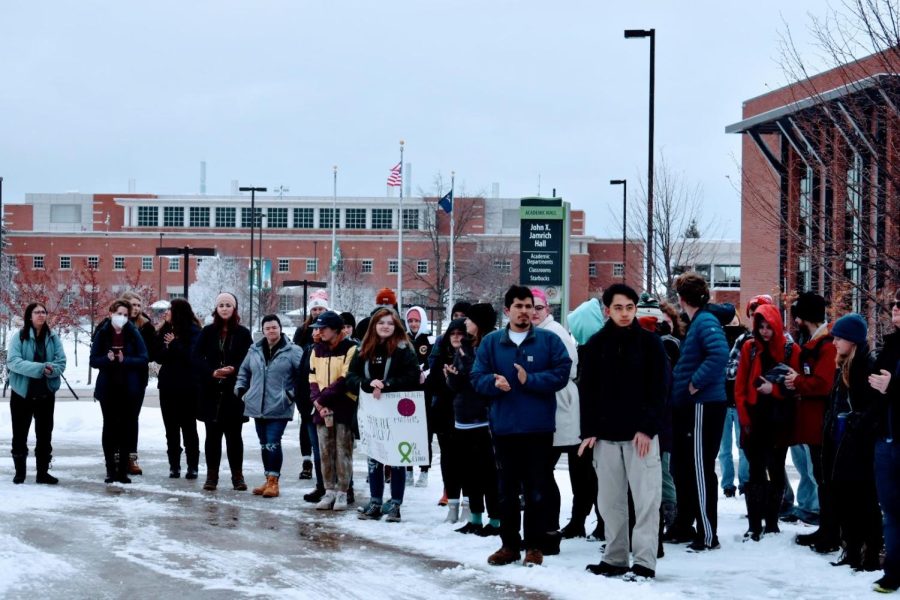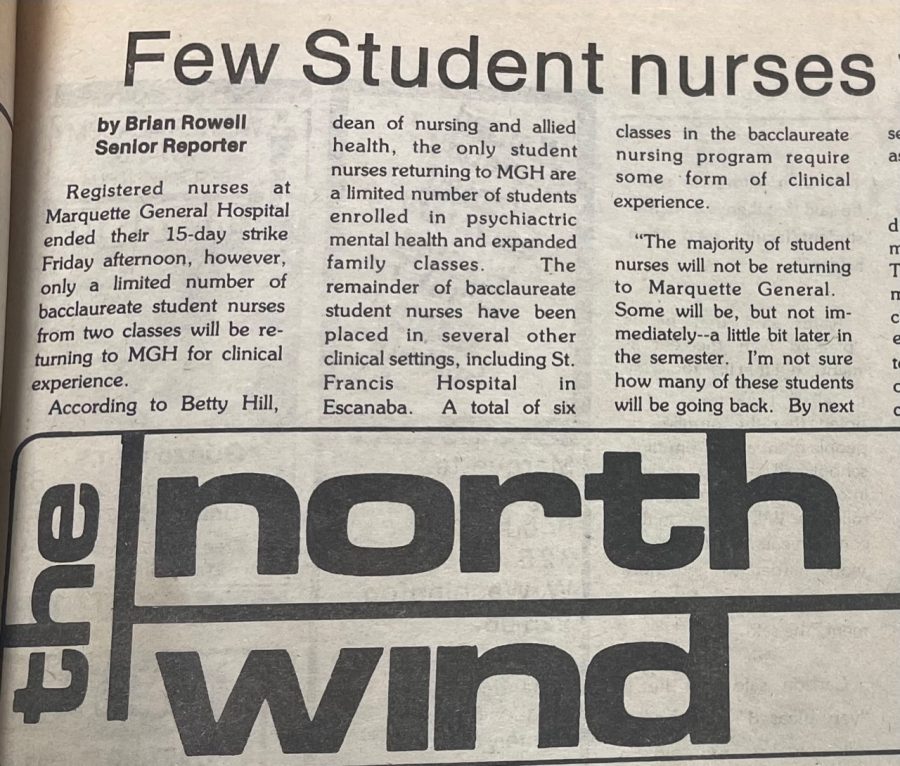Animals watch from a crouched position as parts from 49 wind turbines, each 498 feet long, are trucked through the woods. Roads are widened and trees deforested to allow passage of the massive white blades. Once the turbines are erected, migratory bird patterns are rerouted and wildlife disturbed, as has been the sequence of consequences for wildlife in the past.
This would be the reality if the proposed Summit Lake Wind Project (SLWP), headed by Renewable Energy Systems (RES), were to begin construction in 28,000 acres in the Huron Mountains in June. The Keweenaw Bay Indian Community (KBIC) is concerned for the ecologic and economic future of the land, which is on ceded territory and risks their tribes hunting, fishing and gathering rights.
KBIC President Warren C. Swartz, Jr. and KBIC tribal citizen Jeffrey Loman spoke on KBIC opposition to the SLWP on Monday, April 15 in room LRC 109. The public event was part of NAS 342: Indigenous Environmental Movements and is sponsored by the NMU Center for Native American Studies.
Although opposed to the Summit Lake project, the KBIC is no stranger in the attempt to go green. About 10 years ago, the tribe conducted their own wind energy estimate by installing 100-foot towers near the L’Anse reservation. Discovering that wind was not feasible, they went with solar instead. Professor of NAS 342, Aimee Cree Dunn, said people need to view green energy with a critical eye.
“I am and have always been a supporter of alternative energy; however, we have to put on our critical thinking caps and not just accept anything that labels itself as green energy. Just because it has a wind turbine in it doesn’t mean that it has positive effects,” Cree Dunn said. “Corporations have gotten into this — there’s big money to be made in these wind energy projects.”
Wind energy is useful, Cree Dunn said, but the conversation needs to start examining the label a little closer. The potential site, located six miles east of L’Anse at the highest elevation area in Michigan, was chosen for its “reliable wind source, availability of the electrical grid and compatible use of timberland” as outlined in the RES website. Cree Dunn holds this label under the microscope and highlights three conditions RES should consider for the SLWP: the site location, community consent and energy that is used for the local grid. It’s important that communities supply their own alternative energy in lieu of relying on the “corporate structure,” Cree Dunn said.
The energy generated by the Garden Wind Farm, located near Big Bay De Noc, skirts the local grid and instead is the biggest supplier of utilities for cities south of the bridge, Cree Dunn informed, suggesting that the SLWP might follow suit. Cree Dunn is not wrong in her skepticism, as the RES website said electricity from the SLWP will go into the electric grid that serves the entire region, but is only “made available when the regional transmission operator (RTO) wants it to be.”
A major theory of speakers is that if the area is opened to green energy, corporations will have an incentive to explore the rich metallic and sulfide ore deposits in the area.
“There’s an intriguing possibility that the SLWP would impact the McCormick wilderness which is 93 percent forested,” Cree Dunn said. “People will be up in arms if they put a mine in there, but if you put something green in, people will support it.”
KBIC tribal citizen Jeffrey Loman and speaker at the event said RES is not just deforesting the area to build roads to construct a project. Loman said the company’s “massive road network” will give Weyerhaeuser Timber, the company that owns the land for the proposed wind site, the ability for the 12 sulfide deposits to become economically viable. This loss of forest would affect not only wildlife, but the tribes way of life, said KBIC President Warren C. Swartz, Jr.
“I grew up living on what my mom and dad could feed because we couldn’t afford to go down to the local supermarket. We depended on the fish, deer and gardens,” Swartz said. “We were self sufficient because Grandma and Grandpa taught us how to fish and store food.”
Also connected with the land, President of the Friends of the Huron Mountains, Burt Mason, expressed concern for the ecosystem.
“I think it’s a shame that we destroy a habitat and vibrant ecosystem to put up green energy,” Swartz said. “There’s plenty of places to put green energy — this is a bad location.”
In order to begin construction, RES needs several special land use permits that will grant them access to the land. If the permits are approved, RES anticipates starting construction in June 2019 with commercial operation in November 2020. A permit for a 138 kV overhead transmission line has been applied for. In order to connect to the electricity grid, the line would require a 25-mile road, 20 feet across.
When pressed on why the U.P. was chosen, Mason proposed that the U.P.’s status as a “poor rural community” gives them the ability to “railroad” through the land. Aside from temporary construction jobs, RES predicts the SLWP will give the area eight permanent jobs.
When addressing this issue to policy makers, Mason urges people to look at the bigger picture: the streams and trees are connected by tributaries, so if areas are clear-cut, that’s going to be directed to Lake Superior, eventually, which would affect the world’s largest freshwater body.
In an effort to protect these waters, the KBIC applied for treatment as a state for its water quality standards by the Environmental Protection Agency, and are in a 45-day comment period.
“You’ve heard the negative stories and serious consequences my people are facing when it comes to protecting their way of life. If you could, write a support letter to the EPA and ask them — the indians need some help up there regulating their water quality standard,” Swartz said. “I don’t think the EPA or the State of Michigan is going to take care of it.”
The same water that the crouched animal drinks from will eventually lead to Lake Superior, and the KBIC wants to have the ability to protect those waters.




























